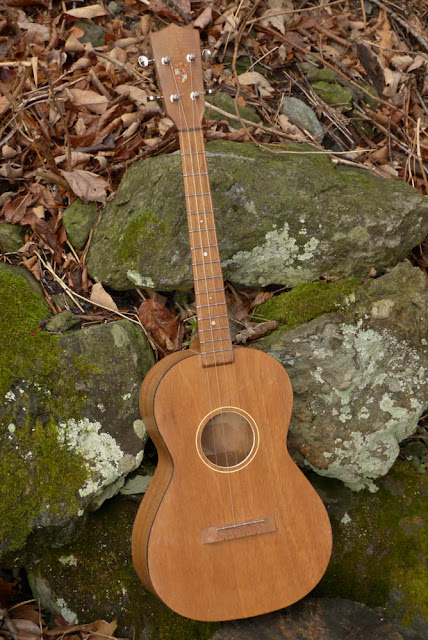1960s Luna (Japanese-made) Baritone Ukulele
I'm a big fan of the old 50s/60s Luna ukes from Japan. This is the same model as one of their baris I worked on a while back. What makes these instruments special is their extreme lightness of build and bracing -- and every single one I've worked-on has had a great sound when it was finished. They shoot (tonally) very much above their mark. In the soundclip I have this tuned to high-D DGBE with a set of soprano/concert uke strings (none wound).
Another interesting quirk with these ukes is that they use their materials very well. This one is made entirely from ply in the body (almost luan-looking stuff -- some sort of ply mahogany-ish wood) but the uke itself is feather-light and only has one brace on the top (below the soundhole) and one on the back (directly below it). Luna used the inherent strength of the ply to cut way-down on bracing compared to your average American baritone and the result is something that sounds more in-character with a nicer tenor or concert uke than the sort of thunky baritone sound I'm used to from everything but Favillas and Martins. It actually reminds me more of sparkly/sweet Latin American instruments (think Venezuelan cuatros) than the average bari. This is a good target to shoot for and the build reminds me, in some ways, of modern Kiwayas.
Work included a fret level/dress, bridge shave/new fret saddle, new tuners, and a decent setup. This play spot on (1/16" action at the 12th fret) and because the body is all-laminate, it'll handle going hither and thither (think: beach, camping) just fine.
I used Kluson-repro tuners to maintain the 50s/60s vibe.
The dots are actually pearl.
This has a 1 1/4" nut width, very thin C-profile neck (fast), and longer 20 1/8" scale length.
I like that the board terminates at the 14th fret. This lets one strum uke-style right above the neck joint.
When I shaved the bridge and re-saddled it, I also converted the stringing method to "hole through." Put the string through the mounting hole, pull it out of the soundhole, knot it/ball it, then pull it back snug and up to the tuner.
Note that the neck itself is actually a quite sturdy/stiff bit of mahogany.
I know they're inelegant but they are functional.
This particular neck has a doweled joint (note the dowel in the middle of the heel).
















Comments
Are those Martin Soprano / Concert strings ?
I'm thinking I like this one with the shaved down bridge and lower action better than the one I bought from you a couple of years ago.
- Jim
If you want to trade, let me know. Is the other one set at 3/32" rather than 1/16"? I do that when I'm stringing with wound strings because they tend to wop against the frets.